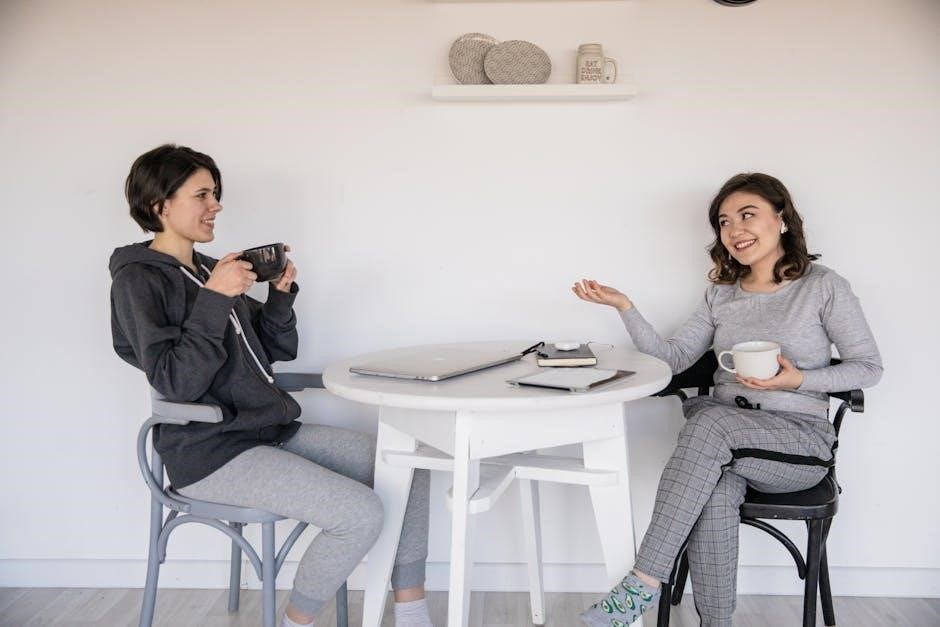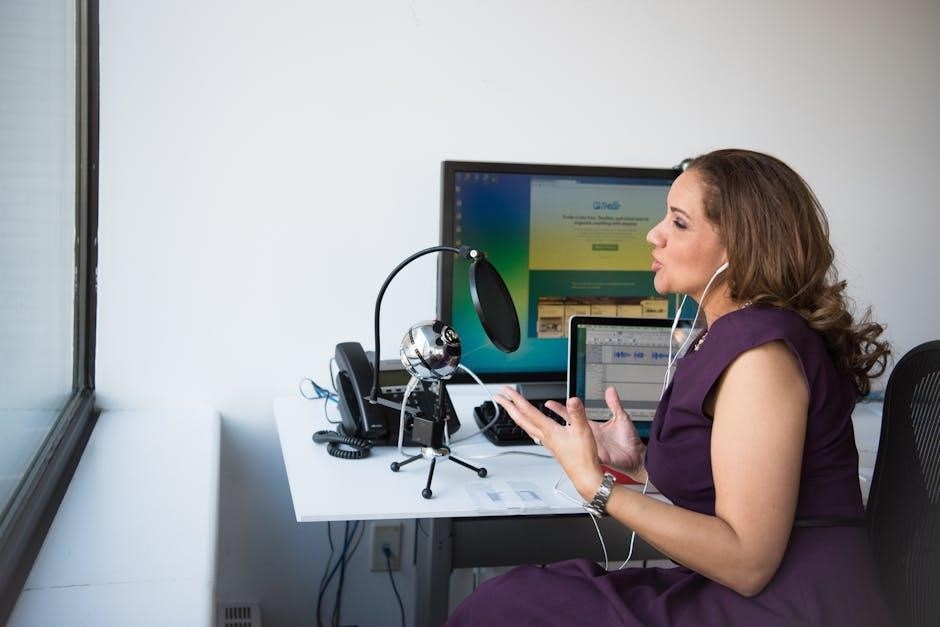Talk Moves are essential strategies for fostering productive classroom discussions, developed by educational experts to enhance critical thinking and collaboration among students across various subjects.
Definition and Purpose
Talk Moves are strategies teachers use to facilitate meaningful classroom discussions, encouraging critical thinking, collaboration, and deeper understanding. These structured communication techniques help students articulate their thoughts clearly and engage with diverse perspectives. The purpose of Talk Moves is to create a dialogic learning environment where students can express their reasoning, question ideas, and build on others’ insights. By fostering intellectual engagement and social-emotional growth, Talk Moves enhance both teaching and learning, enabling educators to assess student understanding and guide instruction effectively.
Historical Background
Talk Moves originated from educational research focused on improving classroom discussions and student engagement. Inspired by works like Suzanne H. Chapin, Catherine OConnor, and Nancy Canavan Anderson’s Classroom Discussions: Using Math Talk to Help Students Learn (2009), these strategies gained prominence as tools for fostering dialogic learning environments. Over time, educators and researchers refined the concept, emphasizing its role in enhancing critical thinking and collaboration. By 2015, publications like Sarah Michaels’ Conceptualizing Talk Moves as Tools further solidified their place in educational practice, highlighting their effectiveness in promoting productive academic discourse across subjects and grade levels.

Benefits of Talk Moves
Talk Moves empower students to articulate ideas clearly, fostering deeper engagement and evidence-based reasoning, while enhancing both teaching and learning experiences effectively.
Intellectual Engagement
Talk Moves significantly enhance intellectual engagement by encouraging students to articulate and clarify their thoughts. Strategies like Revoicing and Restating help students refine their ideas, while Applying Own Reasoning prompts critical thinking. These moves foster deeper analysis and evidence-based discussions, ensuring students move beyond surface-level understanding. By actively participating, students develop a stronger connection to the material, leading to improved comprehension and academic growth. Research supports the effectiveness of these strategies in promoting meaningful intellectual discourse, making them invaluable for enriching classroom interactions and student learning outcomes.
Social-Emotional Learning

Talk Moves foster social-emotional learning by encouraging active listening, empathy, and self-awareness. Students develop communication skills through articulating their thoughts and responding to peers. Strategies like Revoicing and Restating promote understanding and respect for diverse perspectives, enhancing collaboration. By engaging in meaningful discussions, students build confidence and self-awareness, which are critical for emotional growth. These interactions also strengthen relationships, creating a supportive classroom environment where students feel valued and motivated to participate. Talk Moves thus play a vital role in nurturing both academic and social-emotional development.
Academic Achievement
Talk Moves significantly enhance academic achievement by fostering deeper understanding and critical thinking. Strategies like Revoicing and Applying Own Reasoning encourage students to explain their thinking, promoting higher-order thinking skills. This approach helps students connect ideas, solve problems, and understand complex concepts more effectively. By engaging in structured discussions, students develop the ability to articulate their reasoning, leading to improved academic performance. Research also highlights that these moves support evidence-based reasoning, a key component of academic success, and are particularly effective in subjects like mathematics and science.

Core Strategies
Core Talk Moves include Revoicing, Restating, Applying Own Reasoning, Say More, and Time to Think. These strategies facilitate deeper understanding, critical thinking, and meaningful classroom discussions among students.
Revoicing

Revoicing involves paraphrasing a student’s response to clarify their reasoning and encourage deeper reflection. Teachers use this strategy to reflect back what a student has said, ensuring understanding and inviting further discussion. By rephrasing, teachers help students articulate their thoughts more clearly, fostering a collaborative learning environment. This move also prompts peers to engage with the ideas being shared, promoting a deeper exploration of concepts and fostering intellectual engagement in the classroom. Revoicing is a powerful tool for building on students’ contributions and advancing meaningful dialogue.
Restating
Restating is a talk move where teachers ask students to restate another student’s reasoning in their own words. This strategy ensures understanding, clarifies ideas, and builds empathy by encouraging students to consider different perspectives. By restating, students engage deeply with others’ thoughts, fostering a collaborative and inclusive classroom environment. This move also helps identify misconceptions and strengthens the clarity of ideas, promoting intellectual growth and active participation in discussions.
Applying Own Reasoning
Applying Own Reasoning is a talk move where teachers prompt students to connect their own ideas to others’ reasoning. This encourages critical thinking and deepens understanding by linking personal insights to shared discussions. By asking students to explain how their thoughts relate to others’, teachers foster collaboration and intellectual engagement. This move helps students build upon each other’s ideas, promoting a richer and more meaningful exchange of thoughts in the classroom.
Say More
The “Say More” talk move encourages students to elaborate on their ideas, providing deeper insight into their thinking. Teachers prompt students to expand their thoughts by asking, “Can you say more about that?” or “What led you to that conclusion?” This move fosters a culture of detailed explanations and clarifies students’ reasoning. It also models how to engage in thoughtful dialogue, helping students articulate their ideas more effectively and encouraging others to build on their contributions, thus enriching classroom discussions.
Time to Think
“Time to Think” is a talk move that provides students with a brief period to reflect on a question or topic before sharing their thoughts. Teachers often allocate 30 seconds to a minute for students to organize their ideas silently or discuss with a partner. This strategy ensures that all students, especially introverts, have an opportunity to articulate their thoughts more clearly. By giving time to think, teachers encourage deeper engagement, reduce impulsive responses, and create a more thoughtful and inclusive classroom environment, fostering higher-quality discussions and contributions from all learners.

Implementation Tips
Effective implementation of Talk Moves requires creating a safe environment, encouraging participation, and scaffolding discussions to ensure all students engage meaningfully and build confidence in sharing their ideas.
Creating a Safe Environment
Establishing a safe and inclusive classroom environment is crucial for effective Talk Moves implementation. Encourage respect, empathy, and active listening among students. Use strategies like restating and revoicing to validate contributions, fostering confidence. Ensure all voices are heard by providing equal opportunities for participation. Create norms for constructive feedback, emphasizing growth over criticism. A safe environment allows students to take risks, share ideas, and engage deeply in discussions, promoting intellectual and social-emotional growth.
Encouraging Participation
Encouraging participation in classroom discussions is vital for maximizing the impact of Talk Moves. Teachers can use strategies like “Say More” to prompt students to elaborate on their thoughts and “Time to Think” to allow reflection before speaking. Non-verbal cues and intentional questioning can also invite hesitant students to contribute. Pair or group discussions provide opportunities for students to practice articulating their ideas before sharing with the whole class. These approaches ensure all students feel valued and heard, fostering a dynamic and inclusive learning environment.
Scaffolding Discussions
Scaffolding discussions involves gradually releasing responsibility to students while providing structured support. Techniques like “Time to Think” and “Partner Talk” allow students to articulate ideas before whole-class sharing. Teachers use strategies like “Revoicing” and “Restating” to clarify and reinforce student contributions, ensuring understanding. Scaffolding aligns with educational frameworks, promoting deeper engagement and critical thinking. By breaking discussions into manageable steps, teachers empower students to take ownership of their learning, fostering a collaborative and inclusive environment that prepares them for independent academic discourse.

Assessment and Feedback

Assessment and feedback in Talk Moves involve evaluating student participation and understanding through formative strategies, ensuring constructive dialogue that aligns with educational goals and fosters growth.
Formative Assessment
Formative assessment in Talk Moves involves monitoring students’ participation and understanding during discussions. Teachers use strategies like observation, verbal cues, and reflective practices to gauge engagement and depth of reasoning. This approach helps identify areas where students may need additional support or challenges to deepen their thinking. By integrating formative assessment, educators can adjust instruction in real-time, ensuring discussions remain productive and aligned with learning goals. Regular feedback loops also encourage students to articulate their thoughts more clearly, fostering a growth-oriented classroom environment.
Constructive Feedback
Constructive feedback is a cornerstone of effective Talk Moves implementation. Teachers provide specific, actionable comments that guide students in refining their ideas and communication. This feedback focuses on both the content of students’ contributions and the clarity of their expression. By highlighting strengths and suggesting areas for improvement, educators help students build confidence and develop their critical thinking skills. Constructive feedback also encourages active listening and empathy, fostering a supportive learning environment where students feel comfortable sharing their thoughts and engaging in meaningful dialogue with peers.

Evidence and Research
Research highlights the effectiveness of Talk Moves in enhancing classroom discussions, with studies demonstrating improved critical thinking and collaboration among students. Multiple studies have shown that these strategies foster deeper engagement and academic growth, supported by evidence from educational settings worldwide.
Effectiveness Studies
Effectiveness studies on Talk Moves reveal significant improvements in students’ critical thinking and collaboration. Research conducted in various educational settings demonstrates that these strategies enhance academic discourse, leading to deeper engagement and understanding. For instance, interventions implementing Talk Moves in classrooms have shown measurable gains in students’ ability to articulate reasoning and evidence-based arguments. These findings underscore the practical benefits of integrating Talk Moves into teaching practices, supporting both intellectual and social growth in learners. The evidence consistently highlights their positive impact on student outcomes across diverse subjects and age groups.
Case Studies
Case studies demonstrate the practical impact of Talk Moves in real classrooms. For example, a study in a primary classroom showed significant improvements in students’ reasoning and collaboration after implementing Talk Moves. Another case highlighted how these strategies fostered deeper mathematical discussions, with students articulating their thoughts more clearly. Research by Sarah Michaels and others documented classrooms transitioning from recitation to reasoning, showcasing Talk Moves as a catalyst for meaningful dialogue. These examples illustrate how Talk Moves create engaging, intellectually rich learning environments that benefit both students and educators.

Tools and Resources
PDF guides, professional development materials, and classroom discussion strategies are available to support teachers in implementing Talk Moves effectively, ensuring alignment with educational frameworks and student needs.
PDF Guides
Talk Moves PDF guides provide comprehensive strategies for facilitating productive classroom discussions. These resources, developed by educational experts, include practical tools and examples to enhance critical thinking and collaboration. Available for free online, they offer step-by-step instructions, classroom examples, and evidence-based practices. PDF guides are particularly useful for teachers seeking to implement Talk Moves effectively, ensuring alignment with educational standards and student needs. They serve as invaluable resources for professional development, supporting educators in creating a structured and supportive learning environment.
Professional Development
Professional development for Talk Moves involves training educators to effectively implement these strategies in classrooms. Resources like the Talk Moves PDF guide, developed by experts such as Sarah Michaels, offer evidence-based practices to enhance discussion facilitation. These materials provide teachers with practical techniques, classroom examples, and research insights to foster productive conversations. By engaging in professional development, educators can refine their ability to promote critical thinking, collaboration, and deeper student engagement, ensuring alignment with educational standards and student learning goals.
Talk Moves represent a powerful approach to enhancing classroom discourse, fostering critical thinking, and promoting deeper learning. By integrating strategies like revoicing and restating, educators create collaborative environments where students engage intellectually and socially. Evidence-based practices, supported by resources such as the Talk Moves PDF, demonstrate their effectiveness in improving academic outcomes. As schools continue to prioritize meaningful discussions, Talk Moves offer a proven framework for teachers to inspire student growth and achievement, aligning with broader educational goals for equity, engagement, and excellence in learning.